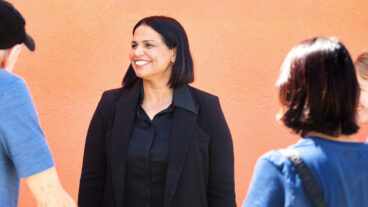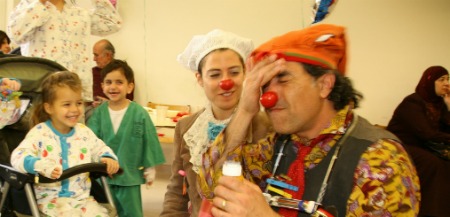
Groucho Marx once said: “A clown is like an aspirin, only it works twice as fast.”
Can that notion be proven scientifically? The question was among those pondered at an October conference in Israel that drew participants from many countries.
Coinciding with the 10th anniversary of Israel’s internationally renowned Dream Doctors therapeutic clowning program, the congress gave visitors a chance to watch clowns in action at Jerusalem hospitals and learn about efforts to promote medical clowning as a standardized, research-backed healthcare discipline.
Israel leads the world in this regard, says Michael Christensen, founder of New York’s Big Apple Circus and its Clown Care Unit. He was among presenters at the conference, where 100 Israelis met 100 counterparts from abroad.
“I am totally and utterly inspired by the way Dream Doctors have integrated themselves into the medical profession in Israel,” says Christensen. He trained theater students at Tel Aviv University to be medical clowns at Schneider Children’s Hospital in Tel Aviv 22 years ago.
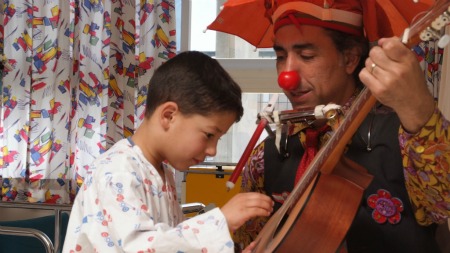
Today, Israel is the only country that offers a bachelor’s degree in clown therapy as a paramedical profession, at the University of Haifa’s Graduate School of Creative Arts Therapies. A master’s program is also planned.
“In the States, our clowns are called upon from time to time to assist in various [medical] procedures, but nothing compared to the depth, consistency and wonderful partnership that I see in Israeli hospitals,” Christenson tells ISRAEL21c.
Dream Doctors founder and chairman Yaacov Shriqui said that 90 Dream Doctors are now working in 22 Israeli healthcare facilities, mainly with children.
“We visit 176,000 children per year, spending an average of 12 minutes per child,” said Shriqui, speaking to an audience that included North Americans, Australians, Portuguese, Danes, Brazilians, Palestinians, Scots, Germans, Dutch, Swiss, Peruvians, French and Russians, among others.
Less stress = less pain medication
Presenters described how medical clowns make a qualitative difference in their hospitals.
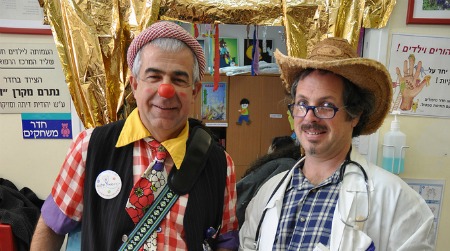
Dr. Yaacov Gozal, associate professor of anesthesiology at Jerusalem’s Shaare Zedek Medical Center, launched a study to see if professional clowns could calm children before outpatient surgical procedures as effectively as bitter-tasting oral sedative syrup. “With less stress, children need less pain medication and can be discharged sooner,” he said.
Gozal’s staff divided the 40 subjects — healthy Israeli kids ages two to 11 — into two groups. Children in the first group each interacted with a Dream Doctor for 15 minutes prior to being anesthetized, while the second group got the sedative. They found that the children’s levels of blood cortisol (a stress-induced hormone) just before surgery were equal in both groups, and that parents felt greater satisfaction with the experience when their child had received clown therapy.
At the same medical center, Dream Doctors have started aiding young cerebral palsy victims during painful botox treatments to relax spastic muscles. Dr. Hilla Ben Pazi said this is sometimes done under general anesthesia because the children are so distressed.
One very anxious eight-year-old girl was about to be treated when the anesthetist was called away for an emergency. With the mother’s consent, Ben Pazi substituted a staff clown for anesthesia. “The child received five recurrent injections, and by the fifth she not only did not cry but even laughed throughout the procedure,” Ben Pazi reported. “This gave us a big push toward research.”
There are many studies on how to alleviate and manage pain during needle procedures in children, she added, but none looked at clown care. Her study, done in conjunction with medical clown Avraham Cohen, showed that although kids didn’t believe they’d experience less pain because of the clown’s carefully orchestrated antics, most were surprised to find it helped.
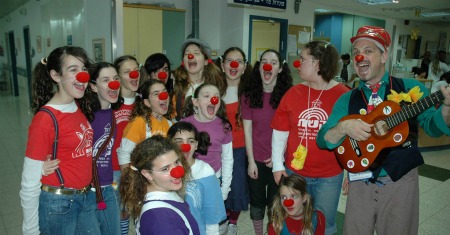
“In the control group, all the kids said they felt severe pain, but only less than a third with clown care said they had severe pain. That’s a big difference,” she pointed out.
At Beersheva’s Soroka Medical Center, six doctors and 17 nurses did a six-month study examining the impact of medical clowning on anxiety levels of hospitalized children. “The clown’s work is most critical when no family is around and before invasive procedures,” Pediatric Hematology-Oncology Head Nurse Liat Maimon reported.
Soroka, which serves a large Bedouin and immigrant population, is also interested in studying how therapeutic clowns lessen stress for caregivers, parents and siblings of patients. “Humor is an ancient secret weapon to distract patients from pain, helps remove barriers and lessen anxiety, and empowers children to deal with pain and fears,” Maimon said.
Clowning during intimate procedures
Dr. Nessia Lang, an ob/gyn at Poriya Medical Center in Tiberias, reported that clown therapy alleviates feelings of pain and fear during pelvic examinations of children who’ve been sexually abused.
“The medical clown has a crucial role in allowing for a thorough exam without retraumatizing the patient,” she said. Kids who’ve been molested have trouble trusting adults, especially adults asking them to spread their legs.
A clown called Shoshi described how she helps the kids feel empowered, such as “arming” them with a syringe of water to squirt or a whoopee cushion to activate in the presence of the physician. She may engage little girls in funny hairstyling competitions to redirect their attention to the upper part of their bodies from lower part where the doctor is working.
“Sometimes in the hardest cases the clown allows us not to use anesthesia in order to do the exam,” said Lang. “And children accompanied by the clown show fewer post-traumatic stress symptoms than children without the clown.”
Dr. Shevach Friedler, head of Assaf Harofeh Medical Center’s Infertility and IVF Unit, ran a study involving more than 200 women lying prone to aid implantation after embryos were introduced into their wombs.
“They are full of anxiety after this procedure and have nothing to take their minds off it,” said Friedler, who studied mime in Paris.
He and Dream Doctors devised a 15-minute routine specifically for these patients, and found that pregnancy occurred much more often in women humored by the clowns. The results were published last January in the medical journal Fertility and Sterility.
“We recommend further investigation in our field and in other fields of medicine,” said Friedler. “We already know that laughter stabilizes blood pressure, facilitates digestion, enhances the immune system, improves circulation, and may produce the release of neuropeptides called beta-endorphins, which are pain reducers.”
Dr. Yaron Lang, head of pediatrics at Emek Medical Center in Afula, headed a study involving 142 babies and children undergoing radionuclide scanning for urinary tract infections, a procedure where the child must lie perfectly still.
Over 14 months, only five percent of the kids undergoing this scan with the help of a clown needed sedation, as opposed to 100% under control conditions. “And some of those 5% should have been excluded because they had mental retardation or other conditions precluding cooperation,” he added.
“Dream Doctors are an integral part of our medical staff, and we’re always looking for more ways to integrate them,” said Lang.
Clowning for worldwide recognition
Shriqui said many countries, including 14 African nations, are eager to adopt Dream Doctors’ methodologies. “Our focus for the next 10 years is getting official recognition so we can bring happiness to as many children as possible in the world,” he said.
Dream Doctors, which has been supported by the Magi Foundation since 2004, is working with the Israel Ministry of Health to build a legal status for the profession and push for worldwide standards.
“Right now, hospitals can just hand out red noses and say ‘go do it.’ Of course we’re not happy with that. But we have to get a thick file of research to achieve official status,” Shriqui said.
Israel is showing the way in both research and practice.
“I find it fascinating that Israel has succeeded in legitimizing medical clowning as a profession while America has failed to do that,” says Amy Korenvaes. She and her husband, Harlan, run a foundation that funds the fledgling Funnyatrics Clown Program at Children’s Medical Center in Dallas, Texas.
“I am hoping to take a lesson home from the model the Israelis created. We have to convince doctors that [clown therapy] is time efficient, financially efficient and healing.”
“We haven’t taken the leap to evidence-based medicine that they have here,” agrees Funnyatrics team leader Tiffany Riley. “Now we can go back and say, ‘Look at how far ahead this country is.’ In this field, we have some things to learn.”












